
Although white cockroaches in an apartment can not be found so often, however, sometimes they still catch the eye - this is where the question arises of what kind of strange albinos they are, are they dangerous for humans and in general, where did they suddenly come from started.
Well, if such an unusual white cockroach caught your eye in the kitchen or in the bathroom, then for a start it should be borne in mind that it practically does not differ from the usual red cockroaches in anything but color - this is not a mutant and not a mistake of nature. Moreover, every red cockroach is milky white several times in its life. True, such transformations happen infrequently, and the white color itself does not last long in the insect, therefore the probability of seeing a pest in such an outfit is rather small.
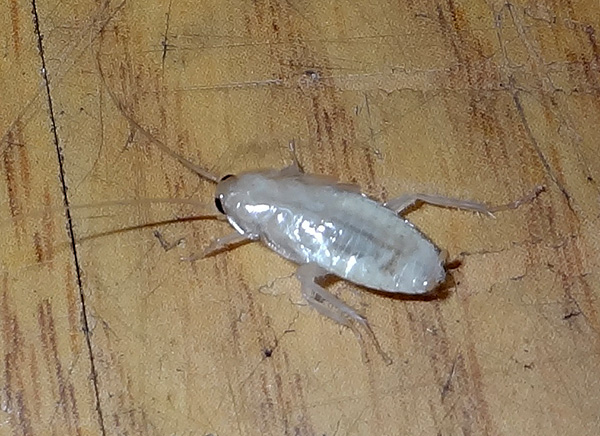
What is the reason for this transformation? Let's figure it out...
Why are cockroaches white?
The normal color of the external integument of a cockroach is due to the presence in its chitinous membrane (cuticle) of a set of special pigments from the melanin group - by the way, chemically similar to those responsible for skin and hair color in mammals.
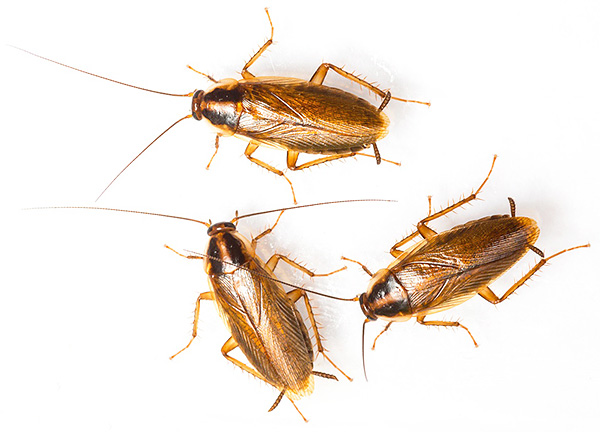
It is interesting
The type of pigment coloration of cockroaches refers to the so-called cuticular color, that is, when the pigments are found exclusively in the outer integument of the insect. Since the cuticle is chemically very resistant, after the death of the insect, the color remains for a very long time.
In some insects, the coloration is hypodermal and subhypodermal - in this case, the pigments are located in the soft tissues under the exoskeleton. Often, after the death of an insect, this color changes quickly - for example, the blue and green coloring of dragonflies after their death quickly becomes faded, grayish-brown.
Red cockroaches - Prussians - have their own specific set of pigments, which differs, for example, from that of black cockroaches. Accordingly, the color of the body and wings of the Prussians is less saturated.
So why are red cockroaches sometimes white?
Small cockroach larvae that have just hatched from eggs have very thin body covers, pigments in their chitinous shells are contained in very small quantities, and therefore outwardly these larvae appear white, almost transparent. Literally within a few days (and sometimes several hours), as the chitinous cover develops and pigments are produced in it, the cockroaches darken and acquire their typical color.
For example, the photo below shows a white larva of a German cockroach (Prusak):
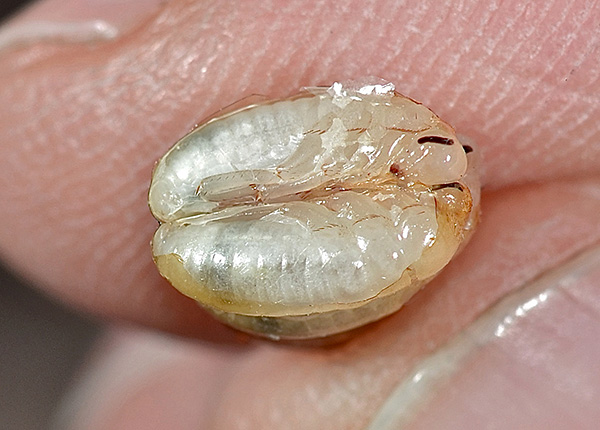
And here are black cockroach larvae that have just hatched from ootheca eggs:
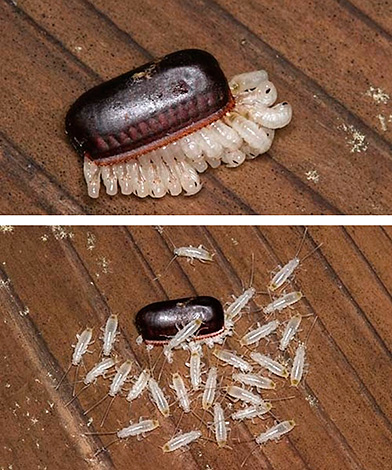
And then - a dark brown female of the Madagascar cockroach and the snow-white offspring "given birth" by her (the Madagascar cockroach belongs to ovoviviparous species, that is, the larvae hatch from eggs in the mother's body, and only then are "born" into the world - such a mechanism increases the survival rate of the young generation) :
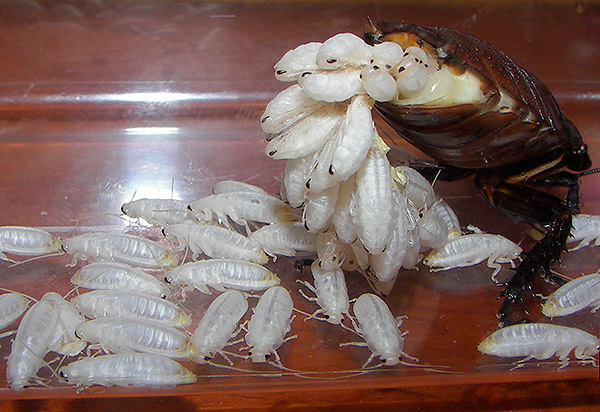
So, given that every domestic cockroach hatches from an egg, any larva at the beginning of its life has a white body color. Therefore, if you meet a small white cockroach in an apartment, you should not think that this is a mutant, it only means that recently the ranks of pests have replenished with 20-30 new small individuals (this is how many eggs are on average in the Prussian ootheca).
It is interesting
Species of cockroaches, the females of which constantly carry egg capsules (ootheca) at the end of the abdomen until the larvae hatch, are more adapted to survival in the natural environment and in apartment conditions. For example, in black cockroaches, the female lays capsules with eggs a few days after they are formed, and only after a few weeks the larvae hatch from such a defenseless capsule. Therefore, a large number of eggs of black cockroaches are eaten by Prussians competing with them, and in nature by beetles, birds and other animals.
But the female Prusaks carry the capsules on themselves until the larvae hatch, as a result of which the survival rate of the eggs is significantly increased.
However, why are there sometimes large white cockroaches in the apartment that have long passed the stage of the first age larvae?
And further: Aerosol Raid killed all cockroaches in 26 seconds. Incredible! See our experiment...
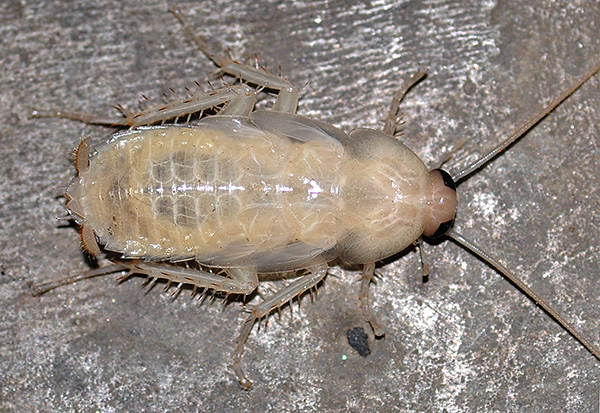
The fact is that as the hard chitinous cover of the larva (nymph) grows, it becomes too small for it - it grows out of it, like a child grows out of its clothes. This shell can be slightly stretched, but does not fully keep pace with the growth of the insect.
Therefore, about 5-7 times before reaching adulthood, the nymph molts, shedding the old cover. Each time at the moment of molting, a grown larva crawls out of the old brownish shell in poorly pigmented, almost white integuments, which again need from several hours to several days to darken.
The photographs below show a freshly shed white Prussian nymph:
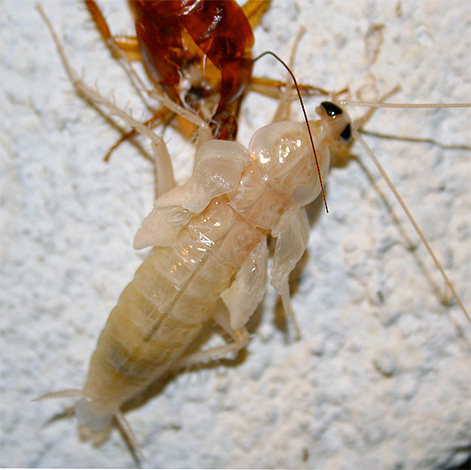
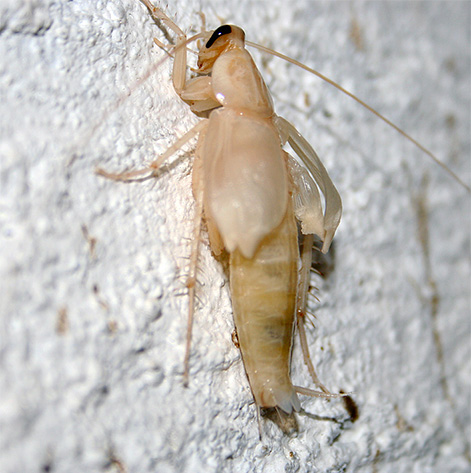
It is these grown-up larvae or adult white cockroaches emerging from the last larval “suit” that residents of apartments and private houses sometimes notice in kitchens, toilets and bathrooms (in places close to water sources).
Pay attention the next time you see a white cockroach: most likely it will not have wings. Still, for 5-6 molts in the larval stage, the insect has only one molt, after which an adult pest with developed wings appears. And taking into account the fact that no more than 20% of insects survive to the last molt, the probability of seeing an adult white pest is very low.
Here are some more photos of white cockroaches:

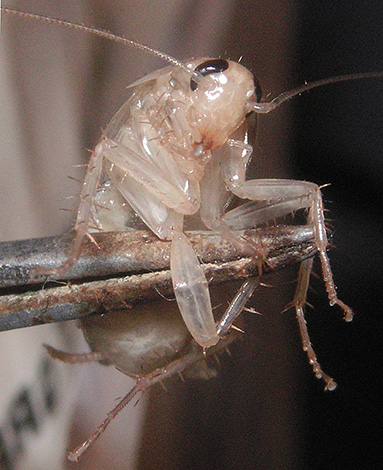
On a note
Obviously, the white color strongly unmasks the insect, especially in nature.Therefore, evolution has contributed to the fact that the integuments of the body of cockroaches darken very quickly, almost simultaneously with drying. Therefore, red cockroaches are white for a rather short period of time.
But certain types of cockroaches, which do not see light at all and live in caves, often have a white color throughout their lives. Here predators do not use sight, and the color of the cockroach does not play an important role in its survival.
White cockroaches in the apartment: why are there so few of them and where are they found most often?
As a rule, cockroaches choose secluded places for molting. This is important for survival, since the individual is most vulnerable at this moment: the chitinous exoskeleton is still too soft and, moreover, unmasks the cockroach with its color.
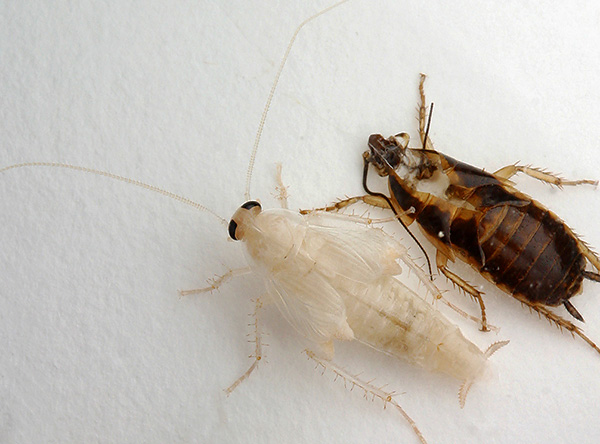
Therefore, it is unlikely that it will be possible to find a white cockroach somewhere on a wall or on a table (however, sometimes this is possible when an individual is disoriented due to the action of any insecticides). Usually, white cockroaches in an apartment sit in the most secluded shelters, waiting for time after the next stage of growing up.
In an apartment or house, white cockroaches are often found during cleaning (when moving furniture or when raking piles of rubbish, among which insects like to hide). If the owner of the apartment is "lucky" and he opens such a shelter just after molting, then he can see milky-white pests.
It is clear that white cockroaches do not possess any unique properties and increased danger (as some impressionable residents sometimes think). They are even more vulnerable than their red relatives and less mobile. Therefore, it is much easier to catch and crush such an "albino" than an ordinary cockroach.

On a note
The total duration of all links and the stay of a domestic cockroach in a white outfit is approximately 2-3 days for its entire many-month life. Considering that at these moments the insects move little and diligently hide, one can understand why they are so rarely seen even with a relatively large number of pests in the room.
White cockroaches in nature
In nature and in the terrariums of exotic cockroach lovers, there are also such species of these insects that, in their adult state, are almost white or simply lightly colored.
For example, the giant cockroach Blaberus giganteus from South America, very famous among terrariumists, has wide translucent wings that cover a light body (see the photo below):
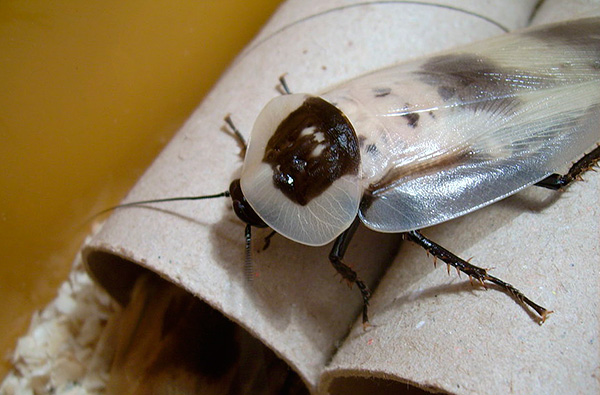
Due to its large size (up to 8 cm) and original coloration, this species is very different from many of its relatives. At the same time, among the dry foliage, in which he spends almost his entire life, this cockroach is just masked by light wings.
Quite similar to a giant cockroach is the so-called "dead head" cockroach (Blaberus craniifer). On its back there is a pattern that vaguely resembles a human skull, for which this insect got its name. In the photo, the cockroach looks black and white:
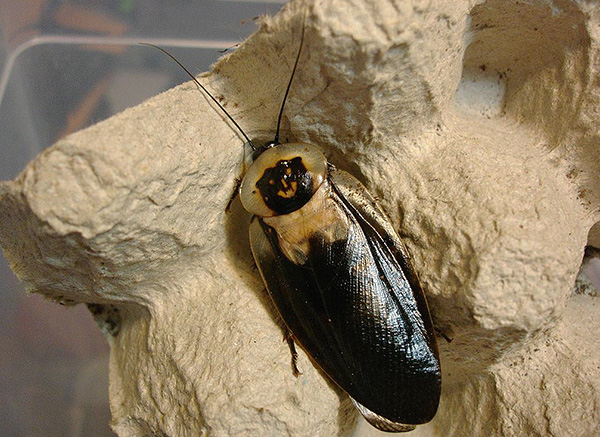
In general, a large number of species of cockroaches live in the tropics, which in adulthood have a light (with shades) color. The photographs below show a few examples.
Madeira cockroach:
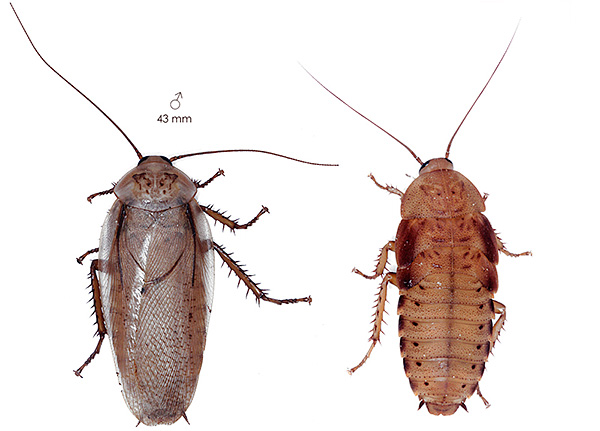
Gyna lurida:
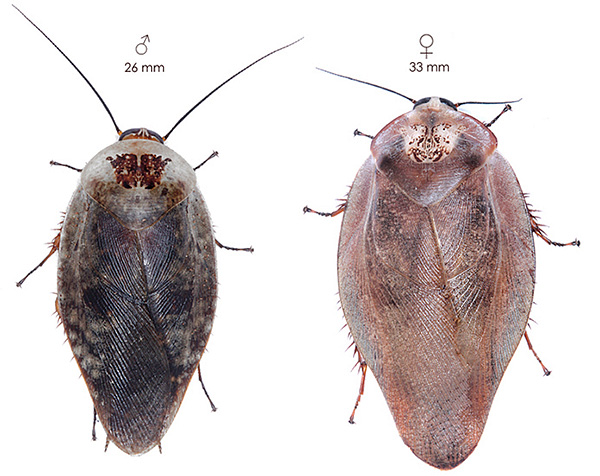
Banana cockroach:
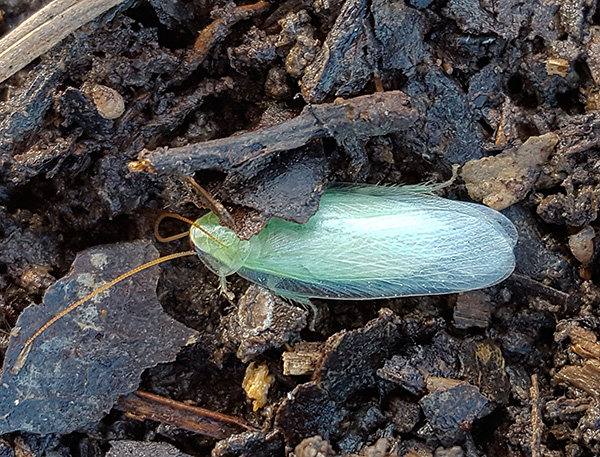
In all these species, the nymphs after leaving the egg and after molting for some time have an almost white color.
Are there true albino cockroaches?
Purely theoretically, albino cockroaches can be found in populations - both in nature and in apartments. As noted above, the dark color of the cuticle is determined by melanocyte pigments, structurally related to those found in the skin and hair of mammals. And if albino rats are found in nature and in laboratories, cockroaches may well exist in which pigments are not produced at all.
However, in practice, albino cockroaches are almost unbelievable to meet for two reasons:
- The primary cause of albinism is gene mutations, and their frequency is extremely low (even among a million normal cockroaches there is almost no chance of meeting at least one true albino);
- In the wild, albino cockroaches are destroyed by predators even in the first larval stages - the white color unmasks them too much. In human housing, the life of a white pest is also unlikely to be long, and few people would understand whether it is an albino or just a recently molted cockroach.
If you have ever met a white cockroach in your house, be sure to share your impressions by leaving a review at the bottom of this page (in the comment box).
Interesting video: cockroach molting (macro)







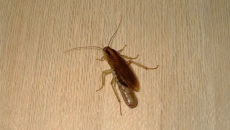
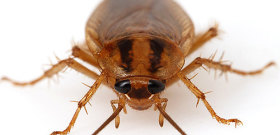

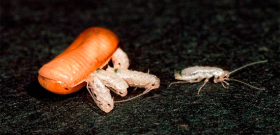
Today I drank coffee and saw an albino cockroach. I am sure of this, since this pest stopped and made it possible to see itself. But he failed to destroy it. Fast too.
Dennis, thanks for the info. I hope you take steps to increase your physical development, and next time do not lose face in front of a cockroach.
The country is behind you, Denis, we are waiting for new victories from you!